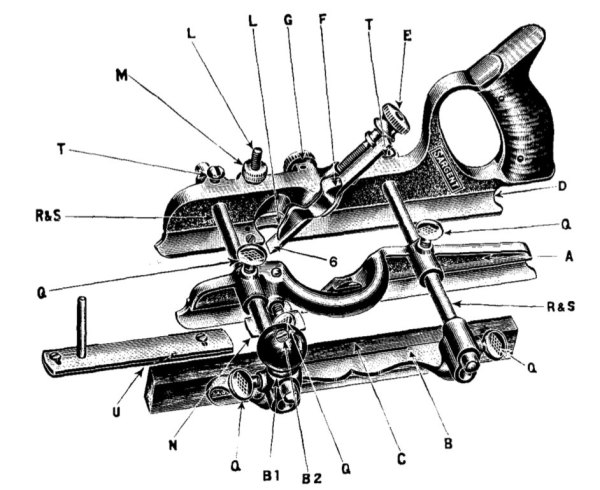Abrasive rust removal comes in one of three forms: rubber “erasers”, Dremel-type abrasive brushes, and wet-and-dry abrasive paper. There are other methods which can be used from an abrasive viewpoint – a wire wheel (quick, but extremely abrasive), or sandblasting (quick, but leaves a rough finish). The caveat with abrasives is that used incorrectly, they can lead to surfaces scratches on the tool. Finer grades of abrasives lend themselves more to polishing than the core rust removal.
Rust Erasers
These “magic” rust erasers, the most common of which is the Sandflex (made by Klingspor), remove rust from cast iron and steel. They are semi-flexible rubber blocks with grit impregnated uniformly in the block. They come in three grit sizes: coarse (60 grit), medium (120 grit) and fine (240 grit).
There is also a similar block (Sabitoru) made in Japan, and geared more towards rust removal on knives (especially high carbon knives). Unlike the Sandflex eraser, which can be used wet-or-dry, the Japanese eraser should be soaked in water for 5-10 minutes before using (they come in fine, medium and rough grits).
In either case, identifying the “grain” of the steel is important to avoid abrasion marks. Here is an example of using a Sandflex fine grained block on the edge of the crank wheel on a Millers Falls hand-drill.
Figure 4 shows an example of using the coarse sandflex block on the sole of a block plane with a medium coating of surface rust. After 30 seconds of “erasing”, the surface rust has been removed. My recommendation would be to apply chemical rust removal to heavily rusted parts, and delegate the erasers to tasks which involve light to medium surface rust.
Abrasive Brushes
For oddly shaped tools, another option is the “detail abrasive brush” for the Dremel. These work on the same basic principle as the Sandflex blocks, rubber bristles embedded with an abrasive and a polishing compound. The brushes come in three grits: Coarse 36 grit (brown), Medium 120 grit (white), Fine 220 grit (red).
An example of how well these brushes work is shown in Fig.6. Each brush does a good removing surface rust from the sole of a block plane, however the 220 grit provides an extremely finely polished surface. Although these brushes are soft, they do tend to leave linear brush marks on the surface, and as such I wouldn’t recommend using them as a “final” surface.
There is also a second type of Dremel accessory – abrasive buffs which come in 180 (dark brown), 280 (light brown), and 320 (purple) grit. They are made of non-woven fibres impregnated with aluminum oxide and silicon carbide. These buffing wheels do remove light surface rust, at a quicker pace than the abrasive wheels, however at the expense of wearing out extremely quickly. Fig. 7 shows two of the buffs, and a sample of their use on the sole of a block plane with surface rust. Both grits produced a clean surface, with the 280 grit polishing the sole.
Abrasive Paper
Abrasive paper for rust removal is normally in the form of silicon carbide – partially because it can be used either in a wet or dry state. Sandpaper can be an extremely effective corrosion removal method, but it requires patience, and a move through successive grades from coarse to fine. Coarse papers such as 80-120 grit remove heavy rust build-up, 200-400 for medium rust, and 600-1000 for removing light rust. Rust removal in this manner requires sanding in the direction of the metal. The benefit of silicon carbide is that finer grades of paper actually will polish the metal.
Thoughts?
I have used various abrasive methods over the past two years, and will elaborate more on testing these in a future post. What have I learnt? The Sandflex rust erasers work well on light to medium surface rust and do not overly scratch the surface of the metal. They also work well in places where the use of chemical rust removers, or the use of abrasive paper is difficult, e.g. the hand drill example shown in Fig.3. The same goes with the abrasive brushes, although these work fast. How well they work on different metals is to be determined. The abrasive buffs are more for polishing, as I imagine that although they do a great job on surface rust – using them could become cost prohibitive as they wear out quickly. I haven’t said much about abrasive papers – mainly because they do work, and are cheap – and come in enough grits to go from rust removal to fine polishing. Stay tuned – more to come (I just need to find some more really rusty tools)!
Availability: I bought the Sandflex blocks at Lee Valley (C$15.95 or US$14.95 for a set of 3), the Japanese Sabitoru I bought at Tosho Knife Arts (C$9 a piece).





























